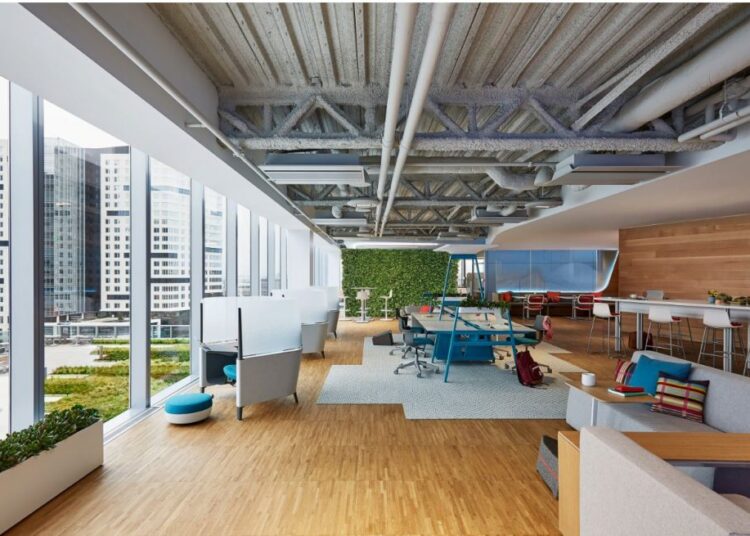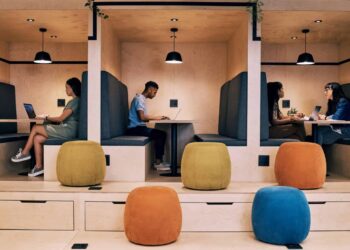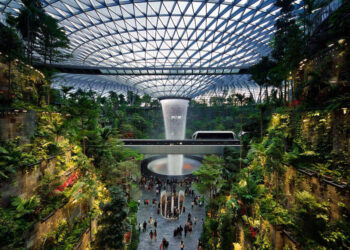Why Workspaces Are Evolving
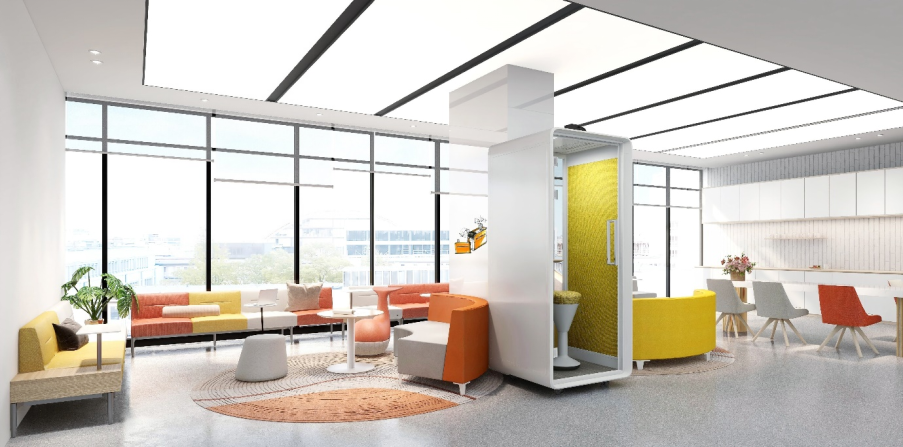
The impetus for this revolution in workspace design is multifaceted. For decades, the conventional office model, largely unchanged since the industrial revolution, prioritized efficiency through standardization and hierarchy. However, the rise of the digital age, the gig economy, and a growing awareness of environmental and social responsibility have rendered this model increasingly obsolete.
A. Technological Revolution: The pervasive integration of high-speed internet, cloud computing, artificial intelligence, and sophisticated communication tools has untethered work from a fixed location. Remote work, once a niche concept, became a global imperative, showcasing the viability and often the benefits of distributed teams. This technological leap has forced companies to reconsider the purpose of a physical office – no longer solely for task execution, but for connection, innovation, and culture building.
B. Shifting Workforce Demographics: Millennials and Gen Z now constitute a significant portion of the global workforce. These generations prioritize flexibility, work-life balance, purpose-driven work, and collaborative environments over rigid structures. They seek spaces that reflect their values, offer opportunities for personal and professional growth, and provide amenities that support their holistic well-being.
C. Sustainability Imperative: Growing environmental concerns have placed a spotlight on the ecological footprint of buildings. Organizations are increasingly committed to reducing their carbon emissions, conserving resources, and promoting sustainable practices. This commitment extends to office design, leading to a surge in demand for green buildings, energy-efficient systems, and eco-friendly materials.
D. Wellness and Employee Engagement: There’s a heightened understanding that employee well-being directly correlates with productivity and retention. Workplaces are no longer just about desks and chairs; they are about creating environments that support mental and physical health. This includes access to natural light, fresh air, ergonomic furniture, quiet zones, and even spaces for exercise and relaxation.
E. Global Crises and Adaptability: Recent global events underscored the critical need for adaptability. Workspaces must be resilient, capable of quickly pivoting to support new work models, and equipped to handle unforeseen challenges. This has accelerated the adoption of flexible, hybrid models that blend in-office and remote work seamlessly.
Core Pillars of Future Workspace Design
The design philosophy behind future workspaces rests on several key pillars, each contributing to a more effective, engaging, and sustainable professional environment.
A. Flexibility and Adaptability
The one-size-fits-all office is a relic of the past. Future workspaces are inherently flexible, designed to accommodate diverse working styles and evolving organizational needs.
A. Activity-Based Working (ABW): Instead of assigned desks, ABW offices offer a variety of zones tailored to different activities – focus rooms for deep work, collaborative hubs for teamwork, quiet areas for contemplation, and vibrant common spaces for informal interactions. This empowers employees to choose the environment that best suits their current task, optimizing productivity and comfort.
B. Modular and Reconfigurable Spaces: Furniture and partitions are often movable, allowing for quick reconfigurations of layouts to support project-based work, training sessions, or sudden team growth. This agility ensures that the physical space can keep pace with dynamic business requirements.
C. Hybrid Work Integration: Design now explicitly accounts for both in-office and remote workers. This means investing in advanced video conferencing technology, ensuring seamless digital access for all team members, and creating spaces where remote and in-person participants can collaborate effectively without feeling disconnected.
D. “Third Places”: Beyond the home and the traditional office, “third places” like co-working spaces, cafes, and even outdoor areas are being integrated into the broader work ecosystem. These offer alternative environments for inspiration, networking, and a change of scenery.
B. Technology Integration
Technology is no longer just a tool within the office; it’s an integral part of the office’s infrastructure, making spaces smarter, more efficient, and more intuitive.
A. Internet of Things (IoT): Sensors embedded throughout the office can monitor occupancy levels, air quality, lighting, and temperature. This data informs intelligent systems that can optimize energy consumption, adjust environmental controls automatically, and even help with space utilization planning. For example, a vacant meeting room might automatically dim its lights.
B. Smart Building Management Systems (BMS): These centralized systems integrate various building functions – HVAC, lighting, security, and access control – to provide a holistic view and enable proactive management. This leads to significant energy savings and operational efficiencies.
C. Advanced Collaboration Tools: Beyond basic video conferencing, future offices incorporate immersive telepresence rooms, interactive digital whiteboards, and augmented reality (AR)/virtual reality (VR) tools for remote design reviews, training, and virtual tours, bridging geographical distances more effectively.
D. Personalized Environmental Controls: Employees might be able to control the lighting, temperature, or even the soundscape around their individual workstations through a smartphone app, enhancing comfort and focus.
E. Predictive Analytics: Data collected from smart office systems can be analyzed to predict peak usage times, optimize cleaning schedules, and even inform future design decisions, creating a continuously improving work environment.
C. Biophilic Design
Bringing the outside in is not just an aesthetic choice; it’s a strategic one, recognizing the profound impact of nature on human well-being and productivity. Biophilic design principles are central to future workspaces.
A. Natural Light Maximization: Prioritizing large windows, skylights, and open layouts to allow ample natural light penetration, which improves mood, reduces eye strain, and regulates circadian rhythms.
B. Abundant Greenery: Incorporating a variety of indoor plants, living walls, and even indoor gardens. Plants improve air quality, reduce stress, and create a calming atmosphere.
C. Natural Materials and Textures: Using wood, stone, and other natural materials in furniture, flooring, and finishes to create a connection to the natural world.
D. Views of Nature: Designing layouts that offer employees direct views of green spaces, parks, or natural landscapes whenever possible.
E. Water Features: The subtle sound and visual presence of water features can have a calming effect, reducing stress and improving focus.
D. Wellness and Employee Well-being
A healthy workforce is a productive workforce. Future workspaces are designed with a holistic view of employee well-being, encompassing physical, mental, and emotional health.
A. Ergonomic Furniture: Providing adjustable desks (sit-stand options), ergonomic chairs, and monitor arms to promote good posture and reduce musculoskeletal strain.
B. Air Quality Monitoring and Filtration: Investing in advanced HVAC systems with HEPA filters and monitoring indoor air pollutants to ensure a healthy breathing environment.
C. Dedicated Wellness Zones: Including spaces for meditation, yoga, quiet reflection, or even napping pods to help employees de-stress and recharge.
D. Access to Healthy Food and Hydration: Offering nutritious food options, filtered water stations, and encouraging healthy eating habits.
E. Active Design Principles: Encouraging movement within the office through staircases as prominent features, walking paths, and proximity to outdoor spaces for breaks.
F. Acoustic Comfort: Designing spaces with proper sound dampening materials, white noise systems, and quiet zones to minimize distractions and support concentration.
Emerging Trends Shaping the Workspace of Tomorrow
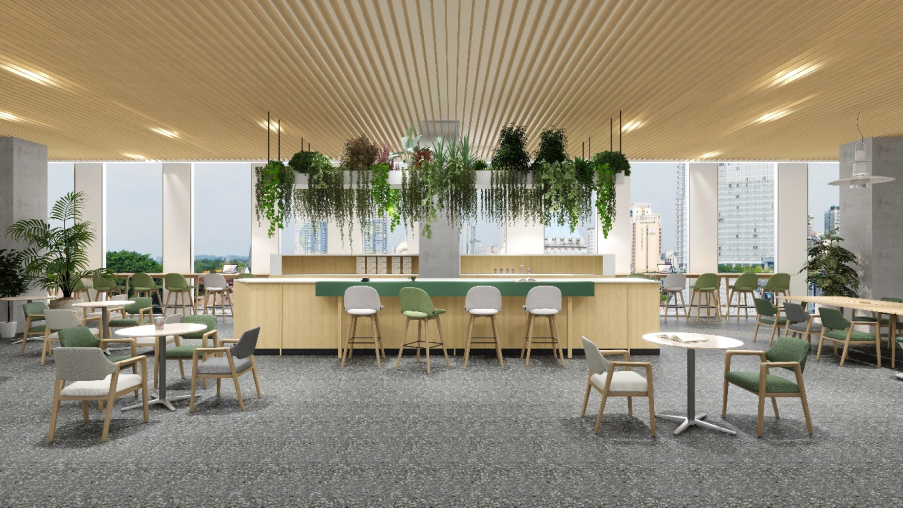
Beyond the core pillars, several exciting trends are gaining momentum, further defining the evolution of the modern office.
A. Hyper-Personalization
The concept of a truly personalized workspace is moving beyond just ergonomic chairs.
A. Individual Environmental Controls: As mentioned, giving employees more control over their immediate surroundings.
B. Tailored Workstation Setups: Allowing employees to choose their preferred monitor setup, keyboard, mouse, and even decorative elements (within guidelines).
C. AI-Driven Personalization: AI could learn individual work patterns and preferences, automatically adjusting lighting, temperature, and even suggesting optimal times for breaks or collaborative sessions.
B. The Rise of the “Third Space” and Co-Working Integration
The office is no longer the sole place for work.
A. Company-Specific Co-Working: Large companies are creating their own flexible co-working hubs in various cities to offer employees more localized and convenient work options.
B. Hybrid Hub-and-Spoke Models: A central headquarters serves as a primary gathering point, supplemented by smaller, distributed satellite offices or co-working memberships closer to employee residences.
C. Hospitality-Inspired Design: Offices are increasingly adopting elements of hotels and high-end cafes, creating inviting, comfortable, and aesthetically pleasing environments that encourage lingering and informal interaction.
C. Sustainable Materials and Circular Economy Principles
Beyond energy efficiency, the focus is on the materials themselves and their lifecycle.
A. Recycled and Upcycled Materials: Using furniture and finishes made from recycled plastics, reclaimed wood, or upcycled industrial components.
B. Locally Sourced Materials: Reducing the carbon footprint associated with transportation.
C. Modular and Disassemblable Design: Creating components that can be easily taken apart, repaired, or repurposed at the end of their life cycle, supporting a circular economy.
D. Waste Reduction Strategies: Implementing comprehensive recycling programs, composting, and striving for zero-waste operations within the office.
D. Data-Driven Design and Optimization
The smart office generates a wealth of data that can inform continuous improvement.
A. Space Utilization Analytics: Understanding which areas are used most frequently and effectively, identifying underutilized spaces, and optimizing layouts based on actual usage patterns.
B. Employee Flow Analysis: Tracking movement patterns to identify bottlenecks or inefficient pathways, and redesigning the flow for better navigation.
C. Environmental Performance Tracking: Continuously monitoring energy consumption, water usage, and indoor air quality to ensure the building operates at peak efficiency and health standards.
D. Predictive Maintenance: Using data to anticipate equipment failures or maintenance needs, reducing downtime and operational costs.
E. Augmented Reality (AR) and Virtual Reality (VR) in Office Design and Collaboration
These immersive technologies are moving beyond gaming.
A. Virtual Office Tours: Potential employees or clients can virtually explore an office space from anywhere in the world.
B. AR for Space Planning: Designers can overlay virtual furniture and layouts onto a physical space to visualize changes before implementation.
C. Immersive Collaboration: VR meeting rooms allow remote teams to feel truly present together, facilitating more natural communication and brainstorming sessions.
D. Training and Onboarding: VR can create engaging and realistic simulations for new employee training or skill development.
The Home Office
The pandemic accelerated the integration of the home into the professional sphere. Future workspace innovation isn’t solely confined to corporate buildings; it extends to optimizing the home office environment.
A. Ergonomic Home Setups: Companies are increasingly providing stipends or resources for employees to invest in ergonomic chairs, standing desks, and proper lighting for their home offices.
B. Technology Parity: Ensuring employees have access to robust internet connectivity, high-quality webcams, microphones, and collaboration software to maintain seamless communication.
C. Designated Work Zones: Encouraging the creation of a distinct, distraction-free area within the home dedicated solely to work, even if it’s a small corner.
D. Wellness at Home: Promoting regular breaks, physical activity, and mental well-being practices for remote workers, acknowledging the blurring lines between work and personal life.
E. Virtual Backgrounds and Privacy: Offering tools and guidance on maintaining a professional appearance and privacy during video calls from home.
Challenges and Considerations
While the vision of future workspaces is exciting, realizing it comes with its own set of challenges.
A. Cost of Implementation: Investing in smart building technologies, sustainable materials, and flexible furniture can be expensive initially, requiring a strong business case for ROI.
B. Data Privacy and Security: The collection of extensive data on employee movement and behavior raises concerns about privacy. Robust security protocols and transparent data usage policies are crucial.
C. Change Management: Shifting from traditional office models to flexible, activity-based working requires significant cultural change management, communication, and training to ensure employee adoption and satisfaction.
D. Digital Divide: Ensuring equitable access to technology and resources for all employees, regardless of their location or socio-economic background, is vital for inclusive hybrid models.
E. Maintenance and Upkeep: Smart technologies and complex systems require specialized maintenance and ongoing support to function optimally.
F. Balancing Collaboration and Focus: Designing spaces that effectively support both spontaneous collaboration and deep, uninterrupted focus remains a key design challenge.
Conclusion
The journey towards truly innovative workspaces is continuous. It’s an iterative process of learning, adapting, and integrating new technologies and philosophies. The goal is not merely to build better offices, but to create environments that empower people, enhance creativity, foster a sense of community, and contribute positively to both the business bottom line and the planet.
These future workspaces are more than just physical locations; they are dynamic ecosystems that reflect an organization’s values, support its strategic objectives, and prioritize the well-being of its most valuable asset: its people. As companies continue to embrace these innovations, we will see a profound and lasting impact on how we work, collaborate, and thrive in the modern world. The future of work is not a distant concept; it is actively emerging in the designs, technologies, and philosophies being adopted by forward-thinking organizations today.

